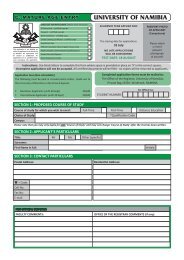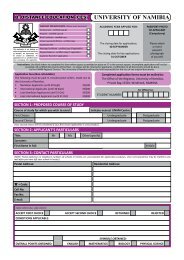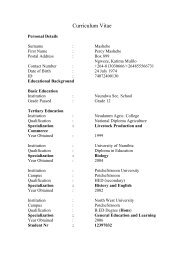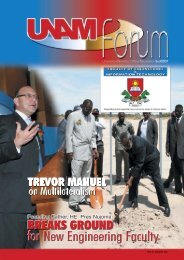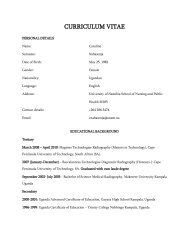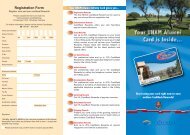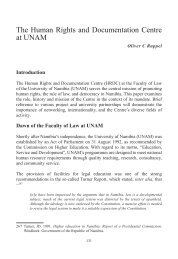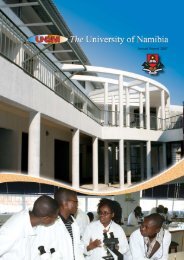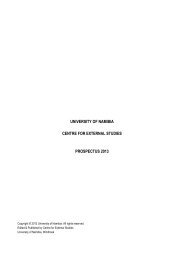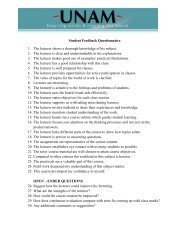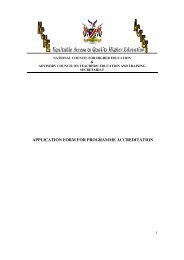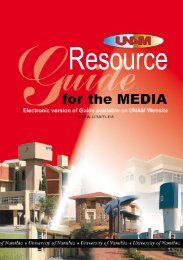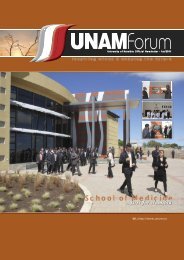Annual Report - University of Namibia
Annual Report - University of Namibia
Annual Report - University of Namibia
- No tags were found...
You also want an ePaper? Increase the reach of your titles
YUMPU automatically turns print PDFs into web optimized ePapers that Google loves.
out along the coast north <strong>of</strong> Henties Bayto collect brood stock and monitor thegonadal development <strong>of</strong> the silver kobArgyrosomus inodorus during 2009. Fourattempts were made to induce spawningin the captive silver kob brood stock atthe Centre during the year, at fi rst usingHuman Chorionic Gonadotropin (HGC)and then Luteinising Hormone ReleasingHormone (LHRH). After the third attempt,it was decided to fatten the brood stockup as much as possible, and this proved tobe the key; the fourth attempt resulted inviable silver kob larvae. SANUMARC staffwill work on improving live feed productionin 2010, in order to feed the larvaewith the correct nutrient requirements.Mariculture hatcheries around the worlduse species <strong>of</strong> micro-algae from generasuch as Isochrysis, Chaetoceros, Pavlovaand Tetraselmis as live food. However, itis relatively diffi cult to acquire the startercultures in <strong>Namibia</strong>, and keep themuncontaminated for any length <strong>of</strong> time.It would greatly benefi t the <strong>Namibia</strong>nmariculture industry to fi nd a local species<strong>of</strong> marine micro-algae that is easy toisolate and keep uncontaminated. To thisend, a potential species was investigatedthat occurs in <strong>Namibia</strong>n salt pans atsalinities <strong>of</strong> about 60 – 70 ppt.SANUMARC attempted to isolate thespecies and feed it to newly hatchedoyster larvae spawned at the Centre. Atfi rst, larval survival was excellent, but aftera few days the larvae died, most likely dueto a lack <strong>of</strong> the correct nutrient balancein the micro-algae. SANUMARC staff alsocollected about 250 Venerupis corrugataclams from Walvis Bay. This local speciescould be a mariculture candidate, andits potential is under investigation at theCentre. The survivorship <strong>of</strong> another shellfi sh,the Pacifi c oyster Crassostrea gigas wasinvestigated when exposed to anoxicconditions in the absence or presence <strong>of</strong>hydrogen sulphide. The lethal exposuretime at which 50% <strong>of</strong> the sample animalsdied (LT 50) was a remarkable 16 days whenexposed to combined hydrogen sulphideand anoxic conditions, increasing to 21days for anoxic conditions.Mushroom cultivationFrom May 2009, trials were conducted atSANUMARC to determine the suitability<strong>of</strong> a traditional clay house building forthe cultivation <strong>of</strong> oyster mushrooms.Parameters such as temperature andhumidity levels were monitored insidethe house, and were compared tothe outside environment. The resultsshowed that the clay house retainedan optimal internal growth environmentfor oyster mushrooms under normalenvironmental conditions. Two strains <strong>of</strong>oyster mushrooms were tested; Pleurotusostreatus florida and Pleurotus sapidus,and promising results were achievedin terms <strong>of</strong> their growth performance.However, the advent <strong>of</strong> the hot, dry eastwind towards the end <strong>of</strong> the trial had aneffect on the results, and the experimentwill be rerun, with the addition <strong>of</strong> amodified drip irrigation system to theclay house, to counter the east windconditions. The successful cultivation<strong>of</strong> mushrooms is highly dependent onthe availability <strong>of</strong> organic materials forsubstrates, such as wheat straw, veld<strong>Annual</strong> <strong>Report</strong> 2009 -59-



